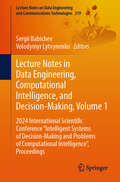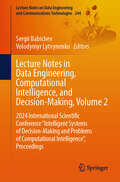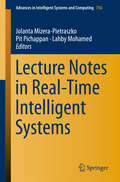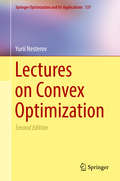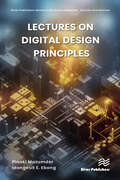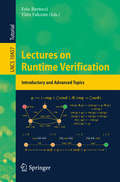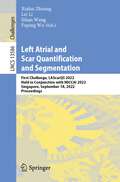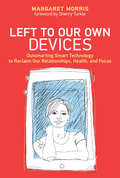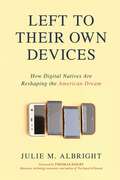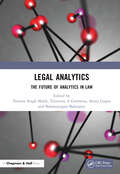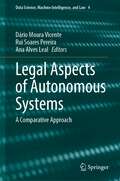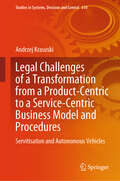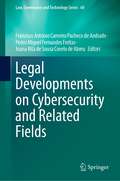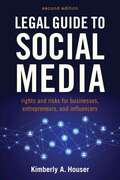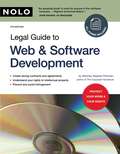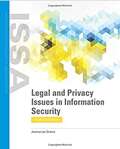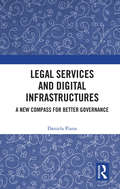- Table View
- List View
Lecture Notes in Data Engineering, Computational Intelligence, and Decision-Making, Volume 1: 2024 International Scientific Conference "Intelligent Systems of Decision-Making and Problems of Computational Intelligence”, Proceedings (Lecture Notes on Data Engineering and Communications Technologies #219)
by Volodymyr Lytvynenko Sergii BabichevThis book addresses contemporary challenges in artificial and computational intelligence, particularly focusing on decision-making systems. It explores current trends in computer science, including the collection, analysis, and processing of information. The advancement of modern information and computer technologies for data analysis and processing in data mining and machine learning is highlighted, showcasing their role in enhancing the efficiency of information processing by reducing time and increasing accuracy. The book comprises 37 scientific papers presenting cutting-edge research in data mining, machine learning, and decision-making. It is categorized into three sections: 1. Analysis and modeling of hybrid systems and processes—14 papers. 2. Theoretical and applied aspects of decision-making systems—7 papers. 3. Data engineering, computational intelligence, and inductive modeling—16 papers. This book is designed for scientists and developers specializing in data mining, machine learning, and decision-making systems.
Lecture Notes in Data Engineering, Computational Intelligence, and Decision-Making, Volume 2: 2024 International Scientific Conference "Intelligent Systems of Decision-Making and Problems of Computational Intelligence”, Proceedings (Lecture Notes on Data Engineering and Communications Technologies #244)
by Volodymyr Lytvynenko Sergii BabichevThis book addresses contemporary challenges in artificial and computational intelligence, particularly focusing on decision-making systems. It explores current trends in computer science, including the collection, analysis, and processing of information. The advancement of modern information and computer technologies for data analysis and processing in data mining and machine learning is highlighted, showcasing their role in enhancing the efficiency of information processing by reducing time and increasing accuracy. The book comprises 16 scientific papers presenting cutting-edge research in data mining, machine learning, and decision-making. It is categorized into three sections: 1. Data engineering, computational intelligence, and inductive modeling—16 papers. This book is designed for scientists and developers specializing in data mining, machine learning, and decision-making systems.
Lecture Notes in Real-Time Intelligent Systems (Advances In Intelligent Systems And Computing #756)
by Jolanta Mizera-Pietraszko Pit Pichappan Lahby MohamedThe second volume of the book series highlights works presented at the 2nd International Conference on Real Time Intelligent Systems, held in Casablanca on October 18-20, 2017. The book offers a comprehensive, practical review of the state-of-the-art in designing and implementing real-time intelligent computing for the areas within the conference’s scope such as robotics, intelligent alert systems, IoT, remote access control, multi-agent systems, networking, mobile smart systems, crowdsourcing, broadband systems, cloud computing, streaming data and many other applications. Research in real-time computing supports decision making in dynamic environments. Some examples include ABS, FBW flight control, automatic air-conditioning, etc. Intelligent computing relies heavily on artificial intelligence (AI) to make computers act for humans. The authors are confident that the solutions discussed in this book will provide a unique source of information and inspiration for researchers working in AI, distributed coding algorithms or smart services and platforms, and for IT professionals, who can integrate the proposed methods into their practice.
Lectures on Convex Optimization: A Basic Course (Springer Optimization and Its Applications #137)
by Yurii NesterovThis book provides a comprehensive, modern introduction to convex optimization, a field that is becoming increasingly important in applied mathematics, economics and finance, engineering, and computer science, notably in data science and machine learning. Written by a leading expert in the field, this book includes recent advances in the algorithmic theory of convex optimization, naturally complementing the existing literature. It contains a unified and rigorous presentation of the acceleration techniques for minimization schemes of first- and second-order. It provides readers with a full treatment of the smoothing technique, which has tremendously extended the abilities of gradient-type methods. Several powerful approaches in structural optimization, including optimization in relative scale and polynomial-time interior-point methods, are also discussed in detail. Researchers in theoretical optimization as well as professionals working on optimization problems will find this book very useful. It presents many successful examples of how to develop very fast specialized minimization algorithms. Based on the author’s lectures, it can naturally serve as the basis for introductory and advanced courses in convex optimization for students in engineering, economics, computer science and mathematics.
Lectures on Digital Design Principles (River Publishers Series in Electronic Materials, Circuits and Devices)
by Pinaki Mazumder Idongesit E. EbongLectures on Digital Design Principles provides students an accessible reference for engaging with the building blocks of digital logic design. The book is an aggregation of lectures for an introductory course and provides a conversational style to better engage with students. Since the text is developed from lectures, important and foundational concepts are highlighted without tedious proofs. With respect to subject matter, students are introduced to different methods of abstracting digital systems, along with the strengths and weaknesses of these different methods. For example, Boolean logic can be represented as algebraic equations, gate level diagrams, switching circuits, truth tables, etc. Strengths and drawbacks to these representations are discussed in the context of Boolean minimization and electronic design automation. The text also delves into dynamic behavior of digital circuits with respect to timing in combinational circuits and state transitions in sequential circuits.
Lectures on Quantum Mechanics: With Problems, Exercises and Solutions (Graduate Texts in Physics)
by Jean-Louis BasdevantBeautifully illustrated and engagingly written, Twelve Lectures in Quantum Mechanics presents theoretical physics with a breathtaking array of examples and anecdotes. Basdevant’s style is clear and stimulating, in the manner of a brisk lecture that can be followed with ease and enjoyment. Here is a sample of the book’s style, from the opening of Chapter 1: "If one were to ask a passer-by to quote a great formula of physics, chances are that the answer would be ‘E = mc2’…. There is no way around it: all physics is quantum, from elementary particles, to stellar physics and the Big Bang, not to mention semiconductors and solar cells."
Lectures on Runtime Verification
by Ezio Bartocci Yliès FalconeThe idea of this volume originated from the need to have a book for students to support their training with several tutorials on different aspects of RV. The volume has been organized into seven chapters and the topics covered include an introduction on runtime verification, dynamic analysis of concurrency errors, monitoring events that carry data, runtime error reaction and prevention, monitoring of cyber-physical systems, runtime verification for decentralized and distributed systems and an industrial application of runtime verification techniques in financial transaction systems.
Lee de Forest
by Mike AdamsThe life-long inventor, Lee de Forest invented the three-element vacuum tube used between 1906 and 1916 as a detector, amplifier, and oscillator of radio waves. Beginning in 1918 he began to develop a light valve, a device for writing and reading sound using light patterns. While he received many patents for his process, he was initially ignored by the film industry. In order to promote and demonstrate his process he made several hundred sound short films, he rented space for their showing; he sold the tickets and did the publicity to gain audiences for his invention. Lee de Forest officially brought sound to film in 1919. Lee De Forest: King of Radio, Television, and Film is about both invention and early film making; de Forest as the scientist and producer, director, and writer of the content. This book tells the story of de Forest's contribution in changing the history of film through the incorporation of sound. The text includes primary source historical material, U.S. patents and richly-illustrated photos of Lee de Forest's experiments. Readers will greatly benefit from an understanding of the transition from silent to audio motion pictures, the impact this had on the scientific community and the popular culture, as well as the economics of the entertainment industry.
Left Atrial and Scar Quantification and Segmentation: First Challenge, LAScarQS 2022, Held in Conjunction with MICCAI 2022, Singapore, September 18, 2022, Proceedings (Lecture Notes in Computer Science #13586)
by Xiahai Zhuang Lei Li Sihan Wang Fuping WuThis book constitutes the First Left Atrial and Scar Quantification and Segmentation Challenge, LAScarQS 2022, which was held in conjunction with the 25th International Conference on Medical Image Computing and Computer-Assisted Intervention, MICCAI 2022, in Singapore, in September 2022.The 15 papers presented in this volume were carefully reviewed and selected form numerous submissions. The aim of the challenge is not only benchmarking various LA scar segmentation algorithms, but also covering the topic of general cardiac image segmentation, quantification, joint optimization, and model generalization, and raising discussions for further technical development and clinical deployment.
Left to Our Own Devices: Outsmarting Smart Technology to Reclaim Our Relationships, Health, and Focus (The\mit Press Ser.)
by Margaret E. MorrisUnexpected ways that individuals adapt technology to reclaim what matters to them, from working through conflict with smart lights to celebrating gender transition with selfies.We have been warned about the psychological perils of technology: distraction, difficulty empathizing, and loss of the ability (or desire) to carry on a conversation. But our devices and data are woven into our lives. We can't simply reject them. Instead, Margaret Morris argues, we need to adapt technology creatively to our needs and values. In Left to Our Own Devices, Morris offers examples of individuals applying technologies in unexpected ways—uses that go beyond those intended by developers and designers. Morris examines these kinds of personalized life hacks, chronicling the ways that people have adapted technology to strengthen social connection, enhance well-being, and affirm identity. Morris, a clinical psychologist and app creator, shows how people really use technology, drawing on interviews she has conducted as well as computer science and psychology research. She describes how a couple used smart lights to work through conflict; how a woman persuaded herself to eat healthier foods when her photographs of salads garnered “likes” on social media; how a trans woman celebrated her transition with selfies; and how, through augmented reality, a woman changed the way she saw her cancer and herself. These and the many other “off-label” adaptations described by Morris cast technology not just as a temptation that we struggle to resist but as a potential ally as we try to take care of ourselves and others. The stories Morris tells invite us to be more intentional and creative when left to our own devices.
Left to Their Own Devices: How Digital Natives Are Reshaping the American Dream
by Julie M. AlbrightA sociologist explores the many ways that digital natives' interaction with technology has changed their relationship with people, places, jobs, and other stabilizing structures and created a new way of life that is at odds with the American Dream of past generations. Digital natives are hacking the American Dream. Young people brought up with the Internet, smartphones, and social media are quickly rendering old habits, values, behaviors, and norms a distant memory--creating the greatest generation gap in history. In this eye-opening book, digital sociologist Julie M. Albright looks at the many ways in which younger people, facilitated by technology, are coming "untethered" from traditional aspirations and ideals, and asks: What are the effects of being disconnected from traditional, stabilizing social structures like churches, marriage, political parties, and long-term employment? What does it mean to be human when one's ties to people, places, jobs, and societal institutions are weakened or broken, displaced by digital hyper-connectivity? Albright sees both positives and negatives. On the one hand, mobile connectivity has given digital nomads the unprecedented opportunity to work or live anywhere. But, new threats to well-being are emerging, including increased isolation, anxiety, and loneliness, decreased physical exercise, ephemeral relationships, fragmented attention spans, and detachment from the calm of nature. In this time of rapid, global, technologically driven change, this book offers fresh insights into the unintended societal and psychological implications of lives exclusively lived in a digital world.
Legacy of Blood
by Richard A. Knaak...and neither Man nor Demon nor Angel will be left unscathed... Norrec Vizharan has become a living nightmare. While on a quest to find magical treasure, the soldier of fortune discovers an artifact beyond his wildest dreams: the ancient armor of Bartuc, the legendary Warlord of Blood. But the mysterious armor soul. Now, pursued by demons who covet the dark armor for their own devices, Norrec must overcome a bloodlust he can scarcely control and learn the truth about his terrifying curse before he is lost to darkness forever... An orginal tale of swords, sorcery, and timeless struggle based on the bestselling, award-winning M-rated electronic game form Blizzard Entertainment. Intended for mature readers.
Legal Analytics: The Future of Analytics in Law
by Namita Singh Malik, Elizaveta A Gromova, Smita Gupta and Balamurugan BalusamyLegal Analytics: The Future of Analytics in Law navigates the crisscrossing of intelligent technology and legal field in building up new landscape of transformation. Legal automation navigation is multidimensional wherein it intends to construct streamline communication, approval and management of legal task. Evolving environment of technology has emphasized need for better automations in legal field from time to time. Although legal scholars took long to embrace Information revolution of legal field. •Describes the historical development of law and automation •Analyses the challenges and opportunities in law and automation •Studies the current research and development in the convergence of Law, Artificial Intelligence and Legal Analytics •Explores the recent emerging trends and technologies that are used by various legal System globally for Crime Prediction & Prevention •Examines the applicability of legal analytics in forensic investigation •Investigates the impact of legal analytics tools and techniques in judicial decision making •Analyses deep learning techniques and its scope in accelerating legal analytics in developed and developing countries • Provides the in-depth analysis of implementation, challenges and issues in the society related to legal analytics The book is primarily aimed at graduates, postgraduates in law & technology, computer science and information technology. Legal practitioners and academicians will also find this book helpful.
Legal Aspects of Autonomous Systems: A Comparative Approach (Data Science, Machine Intelligence, and Law #4)
by Dário Moura Vicente Rui Soares Pereira Ana Alves LealAs computational power, the volume of available data, IT systems’ autonomy, and the human-like capabilities of machines increase, robots and AI systems have substantial and growing implications for the law and raise a host of challenges to current legal doctrines. The main question to be answered is whether the foundations and general principles of private law and criminal law offer a functional and adaptive legal framework for the “autonomous systems” phenomena.The main purpose of this book is to identify and explore possible trajectories for the development of civil and criminal liability; for our understanding of the attribution link to autonomous systems; and, in particular, for the punishment of unlawful conduct in connection with their operation. AI decision-making processes – including judicial sentencing – also warrant close attention in this regard.Since AI is moving faster than the process of regulatory recalibration, this book provides valuable insights on its redesign and on the harmonization, at the European level, of the current regulatory frameworks, in order to keep pace with technological changes.Providing a broader and more comprehensive picture of the legal challenges posed by autonomous systems, this book covers a wide range of topics, including the regulation of autonomous vehicles, data protection and governance, personality rights, intellectual property, corporate governance, and contract conclusion and termination issues arising from automated decisions, blockchain technology and AI applications, particularly in the banking and finance sectors.The authors are legal experts from around the world with extensive academic and/or practical experience in these areas.
Legal Challenges of a Transformation from a Product-Centric to a Service-Centric Business Model and Procedures: Servitisation and Autonomous Vehicles (Studies in Systems, Decision and Control #610)
by Andrzej KrasuskiThis book provides a comprehensive examination of the key legal issues related to the implementation of digital servitisation in mobility business models, focusing particularly on autonomous vehicles. The investigation explores three primary areas of concern.Firstly, it analyses the role of autonomous vehicles within digital servitisation mobility business models, addressing the legal classification of these vehicles and the implications of swarm intelligence. This book informs the evaluation of legal relationships between entities that create value through digital mobility services and the underlying technologies, particularly in relation to autonomous vehicles.Secondly, it considers the legal status and rights of customers in various capacities, including drivers, passengers, and consumers of transportation services provided by autonomous vehicles offering digital service options. Distinguishing these aspects is crucial, as customers are the ultimate beneficiaries of the product-service systems linked to the deployment of autonomous vehicles. Given the complex and multi-stakeholder landscape surrounding these vehicles, customers are exposed to potential risks, especially concerning privacy protection, cybersecurity, and the effective enforcement of consumer rights.The third area highlights the resources required to implement digital business models, including digital platforms. Digital platforms are integral to the ecosystem of entities that create and deliver digital mobility services. Their market position necessitates the establishment of appropriate legal regulations to mitigate their influence.This book is aimed at academic researchers and students, as well as legal professionals associated with vehicle manufacturers and their partners engaged in providing digital mobility services. This demographic encompasses car-sharing companies, digital platform providers, and technology suppliers that facilitate these services, including software for vehicle connectivity and positioning technologies.
Legal Developments on Cybersecurity and Related Fields (Law, Governance and Technology Series #60)
by Francisco António Carneiro Pacheco de Andrade Pedro Miguel Fernandes Freitas Joana Rita de Sousa Covelo de AbreuThis book presents a fresh approach to cybersecurity issues, seeking not only to analyze the legal landscape of the European Union and its Member States, but to do so in an interdisciplinary manner, involving scholars from diverse backgrounds – ranging from legal experts to ICT and engineering professionals.Cybersecurity requirements must be understood in a broader context, encompassing not just conventional aspects, but also emerging topics. This can only be achieved through an interdisciplinary approach. Indeed, cybersecurity should be consistently considered in relation to cybercrime and/or cyber defense, while examining it through the lens of specific domains that are intertwined with various legal fields. Moreover, it is crucial to uphold ethical standards and safeguard fundamental rights, particularly regarding personal data protection.By adopting this comprehensive perspective, the significance of cybersecurity in the exercise of public authority becomes apparent. It also plays an essential role in upholding the fundamental values of both individual Member States and the EU as a whole, such as the rule of law. Moreover, it fosters trust, transparency, and effectiveness in market relations and public administration interactions.In turn, the book draws on the expertise of its authors to provide insights into ICT components and technologies. Understanding these elements holistically is essential to viewing every "cyber" phenomenon from a legal standpoint. In addition to the holistic and interdisciplinary approach it presents, the book offers a captivating exploration of cybersecurity and an engaging read for anyone interested in the field.
Legal Guide to Social Media, Second Edition: Rights and Risks for Businesses, Entrepreneurs, and Influencers
by Kimberly A. HouserLearn how to navigate the ins and outs of the law and social media. How should you respond to a request to remove copyrighted materials from a Facebook page? If you create a Twitter username at work, who owns the username when you change jobs? Can you be sued for libel if someone thinks your posts are defamatory? If you&’ve ever asked yourself these kinds of questions, this pioneering legal handbook is for you. Despite the enormous growth in social media usage by businesses and influencers, very little has been written about the laws affecting their activities. In this new edition of the Legal Guide to Social Media, Kimberly A. Houser, law professor and tech attorney, explains the potential pitfalls and how to avoid them including what social media influencers could have done to protect themselves from the lawsuits resulting from the Fyre Festival debacle. Easy-to-understand, comprehensive, and up-to-date, the Legal Guide to Social Media, Second Edition provides the latest information on case law and statutes. It covers everything from privacy laws to the legal considerations in setting up a page or website as well as new governmental regulations. This plain English legal companion offers examples of and solutions to the kinds of situations you can expect to encounter when posting online content, whether for yourself, your own business, or on behalf of your client&’s business. You&’ll learn how to avoid liability for defamation and third-party posts, how to protect your own content, the unique legal issues surrounding social media in the workplace, and much, much more. The new edition covers new state regulations on privacy, data security and advertising; how to avoid intellectual property infringement actions; and the newer legal risks for influencers.
Legal Guide to Social Media: Rights and Risks for Businesses and Entrepreneurs
by Kimberly A. HouserHow should you respond to a request to remove copyrighted materials from a Facebook page? If you create a Twitter handle at work, who owns that handle when you change jobs? Can you be sued for libel if your posts are defamatory? If you've ever asked yourself these kinds of questions, this pioneering legal handbook is for you.Despite the enormous growth in social media, scant legal advice is available to help the many people who are posting online. Easy-to-understand, comprehensive, and current, Legal Guide to Social Media provides the latest information on case law and statutes. It covers everything from privacy laws to copyright issues to how to respond to employers' requests for your social media passwords. This plain English legal companion offers examples of and solutions to the kinds of situations you can expect to encounter when posting online content, whether for personal enjoyment or on behalf of an employer. You'll learn how to avoid liability for defamation and third-party posts, the legalities of copying and linking to content, how to protect your own content, and much, much more. Whether you're a marketer, entrepreneur, business owner, new media manager, or simply one of the millions of social media users in the United States, this must-have guide will help you to understand and mitigate the most common legal risks inherent in social media use.
Legal Guide to Web & Software Development
by Stephen Fishman J.DProtect your rights, and your hard work! The laws covering website and software development are complex and confusing, but if you don't untangle them, it could cost you thousands of dollars in attorneys' fees and lawsuits. Fortunately, Legal Guide to Web & Software Development decodes this complex area of the law, thoroughly and in reader-friendly English. It also provides contracts, agreements and legal forms on CD-ROM, with step-by-step instructions for filling them out, so you can protect your software and website without paying a lawyer's ransom. Use Legal Guide to Web & Software Development to learn: what kind of legal protection you need the strengths and limitations of each type of protection how to avoid infringement which provisions you need when drafting an agreement how to obtain permission to use other people's materials You'll find complete, step-by-step instructions to draft: employment agreements contractor and consultant agreements development agreements license agreements The 5th edition of Legal Guide to Web & Software Development is completely updated to provide the latest case law and statutory revisions.
Legal Issues in Information Security
by Joanna Lyn GramaThoroughly revised and updated to address the many changes in this evolving field, the third edition of Legal and Privacy Issues in Information Security addresses the complex relationship between the law and the practice of information security. <p><p>Information systems security and legal compliance are required to protect critical governmental and corporate infrastructure, intellectual property created by individuals and organizations alike, and information that individuals believe should be protected from unreasonable intrusion. Organizations must build numerous information security and privacy responses into their daily operations to protect the business itself, fully meet legal requirements, and to meet the expectations of employees and customers. Instructor Materials for Legal Issues in Information Security include: PowerPoint Lecture Slides Instructor's Guide Sample Course Syllabus Quiz & Exam Questions Case Scenarios/Handouts <p><p>New to the third Edition: • Includes discussions of amendments in several relevant federal and state laws and regulations since 2011 • Reviews relevant court decisions that have come to light since the publication of the first edition • Includes numerous information security data breaches highlighting new vulnerabilities
Legal Ontology Engineering
by Núria CasellasEnabling information interoperability, fostering legal knowledge usability and reuse, enhancing legal information search, in short, formalizing the complexity of legal knowledge to enhance legal knowledge management are challenging tasks, for which different solutions and lines of research have been proposed. During the last decade, research and applications based on the use of legal ontologies as a technique to represent legal knowledge has raised a very interesting debate about their capacity and limitations to represent conceptual structures in the legal domain. Making conceptual legal knowledge explicit would support the development of a web of legal knowledge, improve communication, create trust and enable and support open data, e-government and e-democracy activities. Moreover, this explicit knowledge is also relevant to the formalization of software agents and the shaping of virtual institutions and multi-agent systems or environments. This book explores the use of ontologism in legal knowledge representation for semantically-enhanced legal knowledge systems or web-based applications. In it, current methodologies, tools and languages used for ontology development are revised, and the book includes an exhaustive revision of existing ontologies in the legal domain. The development of the Ontology of Professional Judicial Knowledge (OPJK) is presented as a case study.
Legal Photography
by Stan SholikWhile the number of assignments available in many photographic specialties is decreasing, there are still relatively untapped growth areas for still photographers and videographers. One of these specialty fields is legal photography.Legal photography involves working closely with lawyers in law firms to provide photographic or video documentation relevant to their civil, not criminal, cases. It can involve a range of other photographic specialties from macro photography to architectural photography. No matter what is involved in a legal photography assignment, it is generally interesting and presents a new, unique set of problems to solve. Legal photography is far more technical than creative, but it is also in demand and is financially rewarding.Civil cases brought to arbitration or jury trial range from simple to complex. Common to all cases is the need to present evidence in a fair and accurate manner. In this book, readers will learn how to take responsibility for ensuring that the images captured and delivered for presentation are a "fair and accurate representation" of the observed scene. That responsibility begins with the choice and use of the proper equipment (e.g., camera type, sensor size, capture mode, the correct focal-length lens for the job), through the techniques used during image capture (exposure, lighting, camera angle, camera-to-subject distance, white balance, etc.), to the processing of the captures for output. Sholik also points out that documentation is required for each step to ensure all parties that the representation is indeed fair and accurate-and the details of how this can be accomplished are outlined in this book as well.Also covered is information about how to proceed should you be asked to give testimony as to the accuracy of your work and information about the requirements to be deemed an "expert witness." For most photographers, doing assignments in the field of legal photography is the easy part. Getting the assignments can be more of a challenge, so the process of marketing yourself as a legal photographer is covered.
Legal Principles for Combatting Cyberlaundering
by Daniel Adeoyé LeslieThis volume deals with the very novel issue of cyber laundering. The book investigates the problem of cyber laundering legally and sets out why it is of a grave legal concern locally and internationally. The book looks at the current state of laws and how they do not fully come to grips with the problem. As a growing practice in these modern times, and manifesting through technological innovations, cyber laundering is the birth child of money laundering and cybercrime. It concerns how the internet is used for 'washing' illicit proceeds of crime. In addition to exploring the meaning and ambits of the problem with concrete real-life examples, more importantly, a substantial part of the work innovates ways in which the dilemma can be curbed legally. This volume delves into a very grey area of law, daring a yet unthreaded territory and scouring undiscovered paths where money laundering, cybercrime, information technology and international law converge. In addition to unearthing such complexity, the hallmark of this book is in the innovative solutions and dynamic remedies it postulates.
Legal Protection Insurance and Legal Technology: The Legal Framework for Offering Legal Technology with a Particular Focus on the German Market (SpringerBriefs in Law)
by Domenik H. Wendt Constantin JungThis book addresses the legal protection insurance market and continues the collection and analysis of data carried out by Legal Protection International aisbl (at the time, the International Association of Legal Protection Insurance) in recent years. Its first part covers the fundamentals of and recent advances in the legal protection insurance market, while the second presents a study on the relevant legal framework for offering Legal Technology services as a legal protection insurer in Germany. In this context, the study also defines the term “Legal Technology”, categorises Legal Technology services (“application-oriented categorisation”), analyses the relevant European legal framework and highlights the connections to the upcoming European Artificial Intelligence Act.
Legal Services and Digital Infrastructures: A New Compass for Better Governance
by Daniela PianaThis book seeks to provide and promote a better understanding and a more responsive and inclusive governance of the automation and digital devices in public institutions, particularly the law and justice sector. Concerns related to AI design and use have been exacerbated recently with the recognition of the discriminatory potential that can be embedded into AI applications in public service institutions. This book examines issues relating to the assigning of responsibility in a public service produced and delivered on the basis of an automated mechanism. It encourages critical thinking about the legal services and the justice institutions as they are transformed by AI and automation. It raises awareness as to the prospect of transformation we face in terms of responsibility and of agency and the need to design a citizen-centered and human rights compliant system of technology assessment and AI monitoring and evaluation. The book calls for a comprehensive strategy to enable professional practitioners and decision makers to engage in the design of AI driven legal and justice services. The work draws on on-going research and consulting activities carried out by the author across different countries and different systems in the legal and justice sector. The book offers a critical approach to encourage a new mindset among legal professionals and the justice institutions thus empowering and training them to develop the necessary responsiveness and accountability in the justice sector and legal systems. It will also be of interest to researchers and academics working in the area of AI, Public Law, Human Rights and Criminal Justice.
